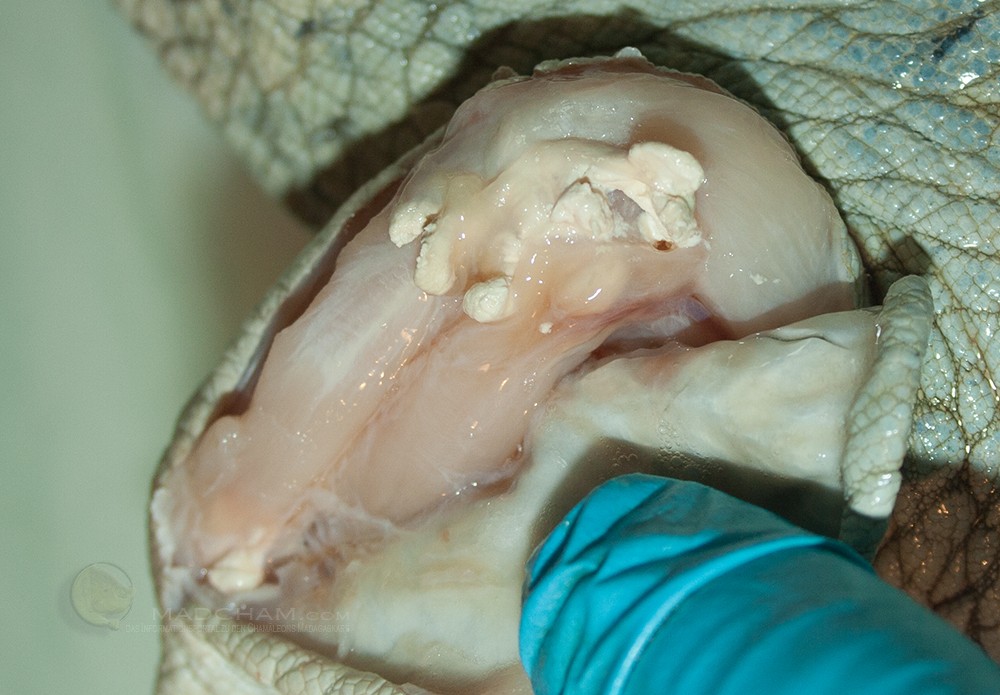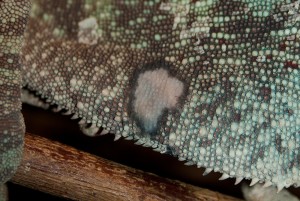What is gout?
Gout is a not curable disease that makes degradation products of protein metabolism deposit inside the body. The disease typically shows attacks with painful joints. In most cases of diseased chameleons, you can rather watch a slowly progressing aggravation of the chameleon’s general fitness due to the renal damages caused by the protein degradation products.

Urate deposits in an opened joint of a Parson’s chameleon that died from gout
How does gout develop?
All feeders contain proteins that consist of amino acids. A chameleon’s liver breaks these proteins down to purines and pyrimidines. The liver also metabolizes purines enzymatically into uric acid that is released into the blood. Passing the kidney, the uric acid comes as crystals into the cloaca (what you find beside the feces of your chameleon is white urate). Urate, which are crystals of the uric acids, and the uric acids itself are poorly soluble in water. Too much of this in the blood or e.g. in joint fluid causes crystal precipitation. Those crystals can be found in organs, blood vessels, or joints. Urates deposited quickly lead to inflammations of the joint cartilage (which is called arthritis). Organs that embed more and more crystals lose their function. The kidneys are affected most, so gout often ends in renal failure. Other preferred organs for crystal precipitation are e.g. the heart sac.
Causes
An increased uric acid level in chameleons may be caused by
- Too less fluid intake,
- overfeeding and malnutrition,
- prior history of renal disease,
- metabolic disorders.
In captivity, the most frequent causes for gout are too high protein intake in combination with too little fluid intake.

Fat liver in a chameleon
Overfeeding and malnutrition
Overfeeding is the most frequent cause of gout in chameleons. Many keepers strongly overfeed their chameleons or use feeders with extremely high protein values (for example wax worms, mealworms, zophobas, and other bug larvae). The more you feed a chameleon, the quicker it grows, the quicker it is sexually mature and the larger it grows, too. Compared to mammals, reptiles need at least 70% less energy intake because they do not need to keep their temperature on a distinct level. Thus a chameleon needs much less food than a mammal of similar size. For example, an adult panther chameleon is sufficiently fed with few feeders on two or three days a week.
Too less fluid intake
Dry cages may be the first step towards gout. Dried out chameleons have a decreased renal elimination function, so more uric acid remains in the blood. Keeping chameleons e.g. free-roaming inside living rooms results – besides many other problems – in low humidity. Especially chameleons from relatively dry regions such as south Madagascar are often kept too dry because the fluid requirement and water existence in the natural habitat are underestimated by the keeper. Even in captivity, many chameleons have a too low water supply. Many chameleons do not begin to drink before it has rained for a long time. The usually used rain systems or cages without a drainage system or drain do not offer the opportunity to imitate long rain. In these cases, a dripper is a great help and offer water constantly to the animal without constraint.
Symptoms
When the keeper recognizes the first symptoms of gout, the disease is already in an advanced stage. Uric acid crystals typically deposit in joints which leads to “swollen” toes, elbow, or hand and foot joints. Some chameleons develop gular edema (fluid inside the gular tissue) due to renal failure. Visceral gout is not visible from the outside at all.
Gout is very painful, even for chameleons. The mobility of diseased animals is restricted by hurting joints. In the late stages of gout, chameleons hardly climb anymore and prefer staying on the same branch for hours. In the final stage, many chameleons let their arms and legs hang from the branch to relieve the painful joints. The progressing renal failure leads to a continuing worsening body condition and apathy.

Gout kidneys
Diagnosis
When you suspect your chameleon to have gout, do not hesitate to visit a reptile experienced vet. The vet will take blood from your chameleon to evaluate the existence of gout. Eventually, he will do an x-ray (gout deposits are not visible inside joints in contrast to many other causes of swollen joints). A dead chameleon can be examined via post-mortem by a reptile veterinarian or a specialized labor to prove that it had gout.
Therapy and care
This disease is not curable, because kidneys cannot regenerate lost tissue. But it is often possible to slow down the progression of gout, and you can, of course, support your sick chameleon’s special needs.
In a gout diseased chameleon, water supply is very important. Your chameleon should always have a running dripper available, and the cage should be sprayed with water several times a day. Soaking the animal by hand may be helpful, too. Often, fluids have to be given via infusions by your vet. Food of these chameleons should be reworked: Less is more! Eliminate all feeders high in protein from the diet (all worms or non-adult insects) and introduce many days without any food.
Medication such as xanthine oxidase inhibitors may help to decrease the production of uric acid inside the liver. Thus it keeps the uric acid level low and fewer crystals may precipitate. The dosage depends on the stage of the disease and condition of the animal. Your veterinarian will advise you and plan an appropriate treatment scheme. Usually, a chameleon with gout needs treatment for the rest of its life. Additionally, the chameleon can get pain killers and inflammation inhibitors during acute attacks.
Sooner or later, gout inevitably leads to renal failure and death of the chameleon. Intensive therapy in early stages can delay the effects of the disease and give the chameleon good life quality. A chameleon that is already in the final stages of gout, moving hardly and being apathetic, should be redeemed from suffering by the vet.














